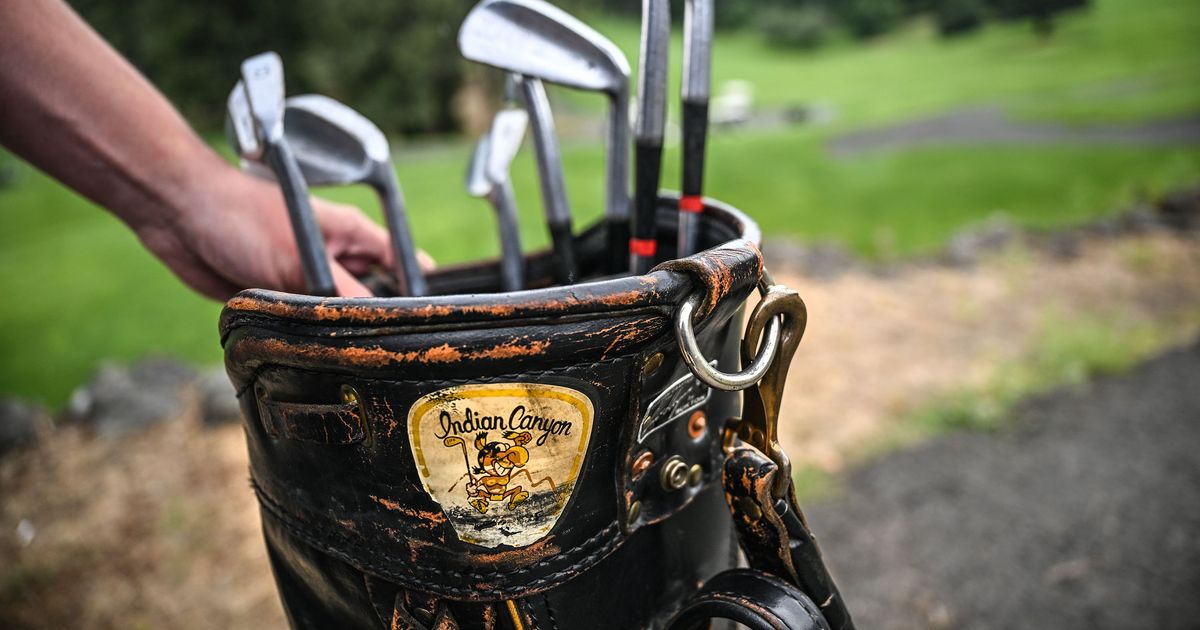The day is Aug. 10, 1947. Ben “The Hawk” Hogan, often touted as the best pure ball striker in history, strode toward the tee on the par-3 fourth hole of the final round at the 1947 Esmeralda Open at Indian Canyon Golf Course in Spokane.
He set his feet and swung. The ball soared, traveling 161 yards to the green and dropped into the hole for an ace.
Though he did not win the tournament, Hogan’s fourth career hole-in-one ignited the crowd, especially a 7-year-old boy. Hogan appreciated the boy’s passion and decided to give him his entire set of clubs after the round concluded.
Today the clubs belong to 17-year-old Central Valley High School varsity golfer Jayden Bommer, who acquired the them in a trade with a fellow Washington-based collector a year ago. He looks at the clubs each time he goes golfing as a reminder that “someone had it tougher than me.”
“It’s really cool to see someone who had such a tough life and a lot of hardships in the past, seeing that he could have just given up on golf completely. He had so many struggles along the way, but no matter what, he kept pushing to go pro,” Bommer said. “The biggest thing is he had a dream and kept going for it and he didn’t let anything or anyone keep him down.”
Hogan used this set of golf clubs shortly after he went pro and it is the earliest known set of existing clubs that he used.
During the tournament at Indian Canyon, Hogan’s clubs were carried by Bill Frazier, the late Gonzaga Prep High School football coach, according to a Spokesman-Review report from 18 years ago.
“As far as I’ve been able to see, these are the earliest set of golf clubs that are used by Ben Hogan. They’re still surviving as his legacy,” Bommer said. “I always look at it as like not the value, but the story behind it.”
The clubs are special to Bommer because of the struggles that Hogan overcame throughout his life. Hogan’s father died by suicide when he was nine, with some accounts reporting that he was in the same room when it happened.
In January 1930, Hogan dropped out of high school when he was 17 to become a professional, but didn’t find success for years. He went broke several times and didn’t win his first tournament until March 1940.
Hogan lost two years of his golf prime while serving in the Air Force during World War II, and he nearly died in a car accident in 1949. He and his wife were struck in a head-on collision with a bus while driving home from a tournament. Hogan sustained severe injuries, including a double fracture of the pelvis, a broken collarbone, a broken left ankle and a cracked rib.
Following his recovery from the accident, Hogan won six majors in a span of eight major starts. Hogan achieved the Triple Crown in 1953, winning the Masters Tournament, U.S. Open and The Open Championship. Throughout his career, Hogan won nine majors and 64 tour events. He is the only player to win the Masters, U.S. Open and Open Championship in the same year. He also has the record for most consecutive top-10 major finishes with 18, and he is one of just six men to win all four majors.
“Not having very much money to begin with and many things in life that could have stopped him from wanting to become pro,” Bommer said, “the story and the message is that somebody that was once really broken was able to make something so awesome.”
Bommer traded some collectible coins and a few vintage golf items in exchange for the clubs. The collector initially obtained the clubs at a garage sale about four years ago. It was nearing the end of the garage sale, and the woman who organized it planned on just throwing the clubs away. It is unknown how she received the set, but the woman almost certainly was unaware that they were Hogan’s.
According to Bommer, the set was in very poor condition at the time of the garage sale. Dust covered the logos and markings that make the set distinguishable. The bag was worn, and a bright yellow Indian Canyon sticker on the side was too warped to recognize.
The collector cleaned everything up and uncovered a custom tag that was crafted by Burton for Hogan. After that, he did a deep internet dive to verify the authenticity of the set. Not only was he able to confirm that Hogan had a custom Burton set, but he was able to match various details about the grip pattern to pictures he found online.
Along with the set, Bommer acquired from the collector a letter that was written by the boy’s family. The letter tells the story of how Hogan gave away his set of clubs to the young fan in August 1947. The letter explains in detail how Hogan was so impressed by how enthusiastic the boy was about golf that he gave him the set, telling him “I can tell you will be an asset to the game. Good luck.”







